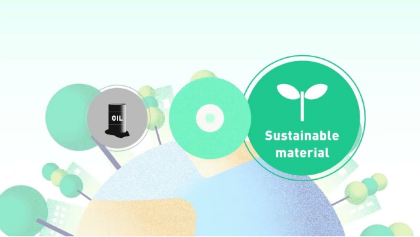Revolefin™
Technology for
producing basic chemicals such as
ethylene and propylene from bioethanol

About Revolefin™
Asahi Kasei’s innovative technology “Revolefin™”
Asahi Kasei’s initiative
Asahi Kasei has been developing “Revolefin™”, the technology to produce basic chemicals such as light olefines (ethylene, propylene, C4 olefines) and aromatics (benzene, toluene, xylene) from bioethanol instead of fossil-based feedstock.

What is Revolefin™?
Polyethylene, used in plastic bags and films; polypropylene, widely used from bottle caps to automotive parts; and PET, used in beverage bottles and textiles, basic chemicals are raw material for these materials. As Revolefin™ technology enables the production of basic chemicals from bioethanol, it allows such commonly used plastics and resins to be made biobased. We are exploring the supply of biobased basic chemicals using mass balance approach.

Concept
Revolefin™ aims to contribute to the realization of circular economy.
The carbon component of fossil-based resource such as petroleum is derived from CO2 stored in the ground in the past. Therefore if conventional plastics are not appropriately recycled, CO2 stored in the ground will be released back into the atmosphere. This is one of the causes of increased CO2 in the atmosphere. On the other hand, the carbon component of biomass resources is derived from the absorption of CO2 by plants through photosynthesis. Therefore, biobased plastics and resins do not lead to an increase in CO2 in the atmosphere, even if such plastics and resins are not fully recycled.
Through Revolefin™ technology, Asahi Kasei aims to promote the adoption of biobased plastics and contribute to reducing CO2 emissions and petroleum consumption.


Technology
Catalytic dehydration is widely acknowledged as a production method of biobased ethylene from ethanol. However, Asahi Kasei’s Revolefin™ will enable the production from ethanol not only of ethylene, but also other light olefins such as propylene, and aromatics such as benzene, toluene and xylene, in a single plant. The implementation of this technology enables the transition of basic chemicals, which serve as raw materials for plastics, resins and synthetic fibers, from fossil-based to biobased.

Biobased basic chemicals
Bio-Ethylene
(C2)Bio-Propylene
(C3)Bio-C4 Olefines
(C4)Bio-Benzene
(C6)Bio-Toluene
(C7)Bio-Xylene
(C8)
-
Features of Revolefin™
- ・ One-stop production of basic chemicals (C2, C3, C4, Aromatics) from bioethanol
- ・ Use of versatile and highly available biomass feedstock, bioethanol as raw material
- ・ Producing biobased chemicals with the same properties as conventional fossil-based basic chemicals
- ・ No extra investment needed downstream for new/upgraded equipment or process changes
-
Benefits of Revolefin™
- ・ Reduction of petroleum usage and CO2 emissions
- ・ Variation of the biobased product
- ・ No property difference in comparison to conventional fossil-based chemicals
- ・ No extra investment needed downstream for new / upgraded equipment or process changes
- ・ Compatibility with recycling alongside conventional fossil-based plastics

Applications
As Asahi Kasei’s Revolefin™ technology enables the production of basic chemicals that are equivalent in quality to those derived from fossil resources, it becomes possible to switch conventional plastics from fossil-based to biobased alternatives while maintaining their functions and performance. In other words, for applications that require the properties and performance of conventional plastics, this technology offers an effective means of reducing petroleum consumption and CO₂ emissions.

Plastics / Resins
Electronics
Food packaging
Automotive devices

Synthetic fibers, Textiles
Clothing
Teddy bear
Carpets

Synthetic rubbers
Shoes
Tires
Gloves

Coatings & Adhesives
Inks
Paints
Adhesives

Chemicals(e.g. Surfactants)
Dish detergents
Shampoos
Cosmetics

Derivatives
Petrochemical derivatives such as polyethylene (PE), polypropylene (PP), and polyethylene terephthalate (PET), which are widely used in plastic and resin applications, are generally produced from basic chemicals. By using Revolefin™ technology to produce basic chemicals from bioethanol, these derivatives can also be made biobased.


Revolefin™ technology enables the production of basic chemicals such as ethylene, propylene, C4 olefins, benzene, toluene, and xylene from bioethanol. As a result, many conventional petrochemical derivatives can be made biobased.



Value Proposition
Current Situation
The carbon component of fossil-based resource such as petroleum is derived from CO2 stored in the ground in the past. Therefore if conventional plastics are not appropriately recycled, CO2 stored in the ground will be released back into the atmosphere. This is one of the causes of increased CO2 in the atmosphere.

Value proposition of biomass
Reducing petroleum consumption and CO2 emissions
The carbon component of biomass resources is derived from the absorption of CO2 by plants through photosynthesis. Therefore, biobased plastics and resins do not lead to an increase in CO2 in the atmosphere, even if such plastics and resins are not fully recycled.
Solving the challenges of 3R
“3R (reduce, reuse, recycle)” initiatives are being promoted in many countries. The use of biomass is expected to further reduce CO2 emissions.
1
Applying biobased chemicals to materials not suited to recycling
・Materials that are difficult to recycle (e.g. PVC, thermosetting resins)
・Chemicals that are difficult to collect (e.g. detergents and paints)
・Composite materials that can be collected but are difficult to separate

2
Applying biobased chemicals as newly input raw materials
Accelerated efforts to reduce, reuse, and recycle will reduce the overall use of fossil-based plastics, but new input materials will still be needed as every plastic has a life span. Biobased chemicals are one effective solution to these problems.


Q&A
FAQ for bioethanol and biobased material
What is Bioethanol?
Bioethanol refers to ethanol produced from plant source biomass feedstock such as corn or sugarcane. Currently, approximately 120 million kiloliters (kL)* of bioethanol are produced annually worldwide. It is widely used not only as a raw material for alcoholic beverages, but also for industrial purposes such as automobile fuel (blended with gasoline) and disinfectants.
The typical raw materials of ethanol include molasses, a byproduct generated during the refining of sugar, and starch contained in corn. More recently, production has also been advancing using cellulose component extracted from sugarcane residue known as bagasse, as well as from woodchips. Bioethanol, being produced from plants and potentially contributing to carbon neutrality, has attracted attention in recent years. Its abundant production volume has also led to consideration of its use in aviation fuel, known as SAF (Sustainable Aviation Fuel), among other applications.
*Reference: OECD-FAO Agricultural outlook 2023-2032
Raw material and production process of bioethanol

What is Bioplastics?
Bioplastics is a general term that refers to two types of plastics: “biobased plastics,” which are produced using biomass as a raw material, and “biodegradable plastics,” which have the property of being decomposed by microorganisms under certain conditions.
The plastics produced from basic chemicals using Asahi Kasei’s Revolefin™ technology is categorized as a biobased plastics.

What is Mass balance approach?
At present, the mass balance method is being increasingly adopted in the chemical industry, especially across Europe. The mass balance approach is a method used when raw materials with different characteristics, such as recycled or biomass-based feedstocks, are mixed. It allocates the attributes of a specific type of input material to a portion of the product, based on the amount of that material used. For example, if 100 tons of product are produced and 75% of the raw material are fossil resource based and 25% are biomass based, producer may attribute biobased content fully to 25 tons of the product.

Advantage of mass balance approach
- 1. Promotes the use of renewable feedstock and contributes to the reduction of CO2 emissions
- 2. Enables gradual increase in the proportion of renewable feedstock in the production process
- 3. Maintains same properties as conventional products
- 4. Utilizes existing infrastructure and process with no need for large investment
- 5. Strengthens the supply chain by third party certification

News

